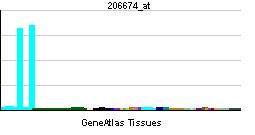Entrez 2322 | Ensembl ENSG00000122025 | |
 | ||
External IDs OMIM: 136351 MGI: 95559 HomoloGene: 3040 GeneCards: FLT3 | ||
Cluster of differentiation antigen 135 (CD135) also known as fms like tyrosine kinase 3 (FLT-3), receptor-type tyrosine-protein kinase FLT3, or fetal liver kinase-2 (Flk2) is a protein that in humans is encoded by the FLT3 gene. FLT3 is a cytokine receptor which belongs to the receptor tyrosine kinase class III. CD135 is the receptor for the cytokine Flt3 ligand (FLT3L).
Contents
It is expressed on the surface of many hematopoietic progenitor cells. Signalling of FLT3 is important for the normal development of haematopoietic stem cells and progenitor cells.
The FLT3 gene is one of the most frequently mutated genes in acute myeloid leukemia (AML). High levels of wild-type FLT3 have been reported for blast cells of some AML patients without FLT3 mutations. These high levels may be associated with worse prognosis.
Structure
FLT3 is composed of five extracellular immunoglobulin-like domains, an extracellular domain, a transmembrane domain, a juxtamembrane domain and a tyrosine-kinase domain consisting of 2 lobes that are connected by a tyrosine-kinase insert. Cytoplasmic FLT3 undergoes glycosylation, which promotes localization of the receptor to the membrane.
Function
CD135 is a Class III receptor tyrosine kinase. When this receptor binds to FLT3L a ternary complex is formed in which two FLT3 molecules are bridged by one (homodimeric) FLT3L. The formation of such complex brings the two intracellular domains in close proximity to each other, eliciting initial trans-phosphorylation of each kinase domain. This initial phosphorylation event further activates the intrinsic tyrosine kinase activity, which in turn phosphorylates and activates signal transduction molecules that propagate the signal in the cell. Signaling through CD135 plays a role in cell survival, proliferation, and differentiation. CD135 is important for lymphocyte (B cell and T cell) development, but not for the development of other blood cells (myeloid development).
Two cytokines that down modulate FLT3 activity (& block FLT3-induced hematopoietic activity) are:
TGF-Beta especially, decreases FLT3 protein levels and reverses the FLT3L-induced decrease in the time that hematopoietic progenitors spend in the G1-phase of the cell cycle.
Cell surface marker
Cluster of differentiation (CD) molecules are markers on the cell surface, as recognized by specific sets of antibodies, used to identify the cell type, stage of differentiation and activity of a cell. CD135 is an important cell surface marker used to identify certain types of hematopoietic (blood) progenitors in the bone marrow. Specifically, multipotent progenitors (MPP) and common lymphoid progenitors (CLP) express high surface levels of CD135. This marker is therefore used to differentiate hematopoietic stem cells (HSC), which are CD135 negative, from MPPs, which are CD135 positive. (See Lymphopoiesis#Labeling lymphopoiesis)
Role in cancer
CD135 is a proto-oncogene, meaning that mutations of this protein can lead to cancer. Mutations of the FLT3 receptor can lead to the development of leukemia, a cancer of bone marrow hematopoietic progenitors. Internal tandem duplications of FLT3 (FLT3-ITD) are the most common mutations associated with acute myelogenous leukemia (AML) and are a prognostic indicator associated with adverse disease outcome.
FLT3 inhibitors
Quizartinib (AC220) and midostaurin were in phase II clinical trials for AML patients with FLT3 mutations. Quizartinib had good results in a phase II clinical trial for refractory AML - particularly in patients who went on to have a stem cell transplant.
Sorafenib has been reported to show significant activity against Flt3-ITD positive acute myelogenous leukemia.
Sunitinib also inhibits Flt3.
Lestaurtinib is in clinical trials.
A paper published in Nature in April 2012 studied patients who developed resistance to FLT3 inhibitors, finding specific DNA sites contributing to that resistance and highlighting opportunities for future development of inhibitors that could take into account the resistance-conferring mutations for a more potent treatment.
